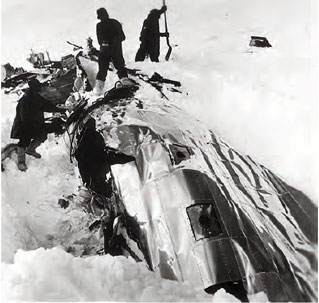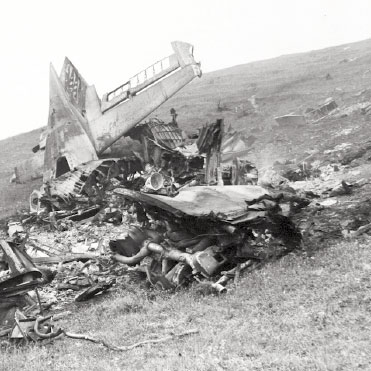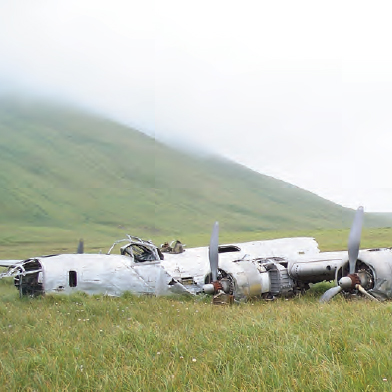During WWII, more than 7,100 air crashes involved US Army Air Force (USAAF) aircraft occurred on American soil. Collectively these crashes resulted in the loss of more than 15,599 lives (Mireles 2006). Many of these military aircraft accidents occurred in remote, often mountainous, areas managed by the National Park Service.
Channel Islands National Park
On July 5, 1943, a Consolidated B-24E Liberator crashed into Green Mountain on San Miguel Island, California, during low overcast conditions (Macha and Jordan 2002; Mireles 2006). The aircraft impacted the ground at cruising speed and the wreckage was widely dispersed and burned (Macha and Jordan 2002). Twelve airmen died in the crash. The accident site was not located until March 19, 1944. A second incident involved a United States Marine Corps (USMC) Grumman F4F, which crashed on Anacapa Island on an unknown date during the WWII (Macha and Jordan 2002).
Death Valley National Park
On August 1, 1944, six B-24 Liberators took off from Muroc Army Air Field for training in gunnery and formation flying. One B-24J collided with, and sheared off the tail of, a B-24D which immediately plummeted. Gunnery student Private Newton J. Steven was thrown from the B-24J and was able to parachute successfully. All the other eight aviators in the B-24J perished along with all eight airmen on the B-24D (Mireles 2006). Scattered debris from the crash is still visible in the park (Macha and Jordan 2002).
On March 29, 1945, an AT-11 crash-landed on Devil’s Golf Course, and the pilot survived (Farabee 2005). The remains of WWII Navy Goodyear FG-1, including machine guns and remains of its pilot, were discovered in the park by a hiker in 1967 (Macha and Jordan 2002). The exact date of this crash is unknown. On September 2, 1945, the last day of the war, a USMC Grumman F6F-5 crashed in Death Valley. The wreckage was not discovered until June 13, 1957 (Macha and Jordan 2002).

courtesy of Kirk Dietz
Denali National Park
On September 18, 1944, an Army C-47 left Anchorage for Fairbanks with a civilian pilot from Northwest Airlines, and 18 servicemen on board. The aircraft struck a mountain (now named Mt. Deception) 16 miles east of Mt. McKinley (Figure 1). Forty-four men traversed over twenty miles of rugged terrain to reach the crash site on November 10, to find the plane buried in ten feet of snow. They were unable to locate any bodies (DNPP, n.d.; Farabee 2005).
El Malpais National Monument
A USAAF Consolidated 0A-10 (Army designation for Navy PBY-5A Catalina) was on route from Amarillo, Texas, to Mather Field, near Sacramento, on August 1, 1945. The aircraft crashed after having feathered one propeller (indicating an engine failure), killing all six crewmen (C. Fuller, pers. comm.; Mireles 2006).

Courtesy of Stephen Haller
Golden Gate National Recreation Area
Shortly after noon on May 4, 1945, a PBY-5A Catalina left Alameda, California, with a crew of eleven, and four depth charges. Barely five miles from Alcatraz Island, the aircraft encountered bad weather and the plane crashed on a hillside a few minutes later. Two of the crew, Aviation Machinist’s Mate Harold R. Doyle and Aviation Ordnanceman Henri C. Tondreault, miraculously survived, but sustained third-degree burns (GGNRA, .d.; C. Fuller, pers. comm.).
Grand Canyon National Park
On June 20, 1944, a B-24 with a five crew members was 24,000 feet over the Grand Canyon, Arizona, when all four engines died. The pilot ordered his crew to bail out, and three men exited through the bomb bay into the night. As suddenly as they stopped, the four engines restarted and the two pilots were able to nurse the plane to Kingman Army Air Field. All three crew members who jumped from the plane survived: Engineer Corporal Roy W. Embanks was uninjured; Lieutenant Charles Goldblum (bombardier) slid down a steep slope and his parachute snagged on the rocks; and Flying Officer Maurice J. Cruikshank, Jr. (navigator), hit a steep slope and broke bones in his foot. Cruickshank, with a makeshift crutch, was able to meet up with Goldblum in the morning, and eventually they found Embanks. Supplies were dropped to them by air, and they were finally led out of the canyon after 10 days (Ghiglieri and Myers 2001; Farabee 2005).
Great Smoky Mountains National Park
On Monday, January 31, 1944, A UC-78 left Charlotte, North Carolina, on route to Nashville, Tennessee, with four on board, including an Oak Ridge scientist. Witnesses reported a low flying aircraft with a sputtering engine over the mountains. Despite immediate and subsequent searches, no trace of the aircraft was ever found (Wadley and McCarter 2002).
Guadalupe Mountains National Park
On December 23, 1943, a Boeing B-17G took off from Roswell Army Air Field in New Mexico, with three senior flight instructors on board. The aircraft was flying in poor isibility, about 200 feet above a paved road, and struck the eastern slope of Guadalupe Peak. Engineer Private Nick A. Mardesich was in the radio compartment at the moment of impact, was able to exit the burning wreck, and was the sole survivor. Some wreckage is still visible (GMNP, n.d.; Mireles 2006).
On the last day of 1943, a Consolidated B-24D left Biggs Field in El Paso, Texas, on an instrument training mission, and struck a hill west of Pine Top. The accident was attributed to icing, and all five members of the crew were killed. Extensive wreckage exists at the site today (GMNP, n.d.; Mireles 2006).
These sites are closed to the public except through limited access grants through special use permits.
Joshua Tree National Monument
On Independence Day 1944, three Consolidated B-24Js left March Field for gunnery and bombing raining. Two of the aircraft collided in flight, shearing off the tail section of one (Farabee 2005; Mireles 2006). Second Lieutenant George B. Smallfield was thrown from his aircraft, and managed to attach and deploy his parachute in free fall, but the remaining nine members of his crew perished (Farabee 2005; Mireles 2006). The pilot from the other plane, Second Lieutenant Gerald Solheid, ordered his crew to bail out. Seven airmen parachuted to safety, however, one was seriously injured. Subsequently Solheid and his co-pilot managed to land their aircraft at Palm Springs (Farabee 2005; Mireles 2006).
Lake Clark National Park
On June 1, 1942, a B-18 with a four man crew crashed into the 11,000 ft Mt. Redoubt, Alaska, which is now within Lake Clark National Park. Seventeen days later, two of the crew, Sergeant Don Harris and Sergeant Charles Michaelis, had made their way to Anchorage. Both the pilot, Lt. Ed Clark, and co-pilot, Lt. Joe Donaldson, sustained injuries, but were eventually rescued from the remote site (Farabee 2005).
Lake Mead National Recreation Area
Lieutenant Laurence E. Wernberg was flying one of five new Vultee BT-13 Valiants to be delivered to Kelly Field, in Texas. On the first leg to Winslow, Arizona, on August 11, 1940, the aircraft developed engine trouble over Lake Mead. Wernberg glided towards the lake surface, but hit a cable and plunged into the water, near Hoover Dam (Farabee 2005).
Olympic National Park
Early on the morning of September 9, 1941, a Douglas B-18A was on a night navigation training flight when it collided with a cliff on Mt. Constance, in Olympic National Park. The entire crew of six was killed on impact. The wreck was not discovered for several weeks after the crash (Mireles 2006).
Saguaro National Park
At least four WWII military plane crashes are documented in Saguaro National Park. On July 30, 1943, a Consolidate B-24D Liberator hit the Tanque Verde Ridge in Saguaro National Park, and nine airmen lost their lives. Much of the wreckage was removed in 1960, under a Special Use Permit (SNP, n.d.; Farabee 2005; Mireles 2006).
An AT-6 crashed north of Paige Creek, just inside the park boundary, on December 28, 1942. An exchange officer from the RAF was killed in the incident. Very little debris remains at the site (SNP, n.d.).
On December 24, 1944, a Cessna UC-78B Bobcat took off from Yuma Army Air Field to fly to Deming, New Mexico, with a pilot and two passengers. The aircraft crashed into the base of the Rincon Mountains at an elevation of 6,400 feet, in a rainstorm with icing conditions. The engines and some fuselage pieces were retrieved by the Pima Air and Space Museum in 1979 (SNP, n.d.; Mireles 2006).
On January 20, 1945, a North American B-25D Mitchell struck Wrong Mountain at about 6,500 feet. The impact sparked a 510-acre fire, and the five crewmen on board perished. Most of the scattered wreckage remains because of the remoteness of the location (SNP, n.d.; Farabee 2005; Mireles 2006).
Sequoia and Kings Canyon National Parks
Several WWII military plane crashes have been documented in Sequoia and Kings Canyon National Parks. On October 24, 1941, 19 Curtis P-40 Hawks of the 57th Pursuit Group left March Field at Riverside, California, to fly to McClelland Field, in Sacramento, California. A short time after takeoff, the aircraft encountered heavy overcast conditions, and many of the aircraft became separated. Four planes went down in the area of Kings Canyon, resulting in one pilot being killed, and three pilots parachuting to safety. First Lieutenant Richard N. Long was killed in a crash near South Guard Lake.
Second Lieutenant John Pease bailed out, after losing oil pressure, north of Lake Isabelle, and he was rescued relatively quickly. First Lieutenant Leonard C. Lydon and Second Lieutenant Jack C. West both bailed out near Barton, California. The two pilots found each other, and were spotted several days later by a B-18 (Farabee 2005; Macha and Jordan 2002; Mireles 2006).
On November 18, 1942, a Beech AT-7 Navigator from Mather Field, near Sacramento, struck the Mendel Glacier in Darwin Canyon. The wreck site was not located until 1947. The partially mummified bodies of two airmen were found in 2005 and 2007, but the remains of the other two crewmen have yet to be found (Farabee 2005; Mireles 2006; Stekel 2010).
On December 5, 1943, a Consolidated B-24E disappeared over the Sierras on a celestial navigation flight with six crewmen on board. Investigators speculated that adverse weather may have been encountered. On July 7, 1960, the wreckage was found at Lake Le Conte. The aircraft had apparently struck the mountain near the top of a 12,500 feet ridge, then slid down into the lake.
For a decade, the father of the 23-year-old co-pilot (Second Lieutenant Robert M. Hester) searched for the site of the crash. In December 1960 the lake was renamed Hester Lake (Macha and Jordan 2002; Farabee 2005; Mireles 2006).
A USMC Curtiss-Wright R5C-1 (incorrectly identified as a C-46 by Farabee [2005]) crashed during a winter snowstorm near Mt. Whitney, at about 11,000 feet, on February 2, 1945. It was five months before the wreck was found and the bodies of the eight crewmen were recovered. The almost intact wreck was removed by USMC helicopters in the summer of 1974 at the request of National Park Service (Macha and Jordan 2002; Farabee 2005).
Shenandoah National Park
On October 17, 1943, four P-47Ds were practicing high altitude formation flying when one was seen to enter a dive at 32,000 feet. The aircraft exploded on impact, seven miles southwest of Elkton at an elevation of 2,000 feet, and the pilot was killed (Mireles 2006).

National Park Service. Courtesy of Janis Kozlowski
WWII Valor in the Pacific National Monument
The only combat-related aircraft loss reported herein is from WWII Valor in the Pacific National Monument, and involves a B-24D Liberator that crash landed on Atka Island, Alaska. The B-24D participated in 18 bombing missions in the Aleutian Islands. On December 9, 1942, the aircraft was involved in a weather reconnaissance flight (such flights were considered combat missions). Bad weather prevented the B-24 from returning to Adak, and so it was forced to crash land in Bechevin Bay, on Atka Island. There was only one minor injury among the crew. The well-preserved plane is still fairly intact (Figure 4), and it was recently designated a distinct unit of WWII Valor in the Pacific National Monument (NARA, n.d.).
Yellowstone National Park
Just after midnight on May 23, 1943, a B-17F en route from Marysville, California, to Lewiston, Montana, crashed four miles south of West Yellowstone. Bad weather conditions prompted an order to bail out. Bombardier Second Lieutenant William F. McDonald immediately exited through the nose hatch, but the remaining crew and one passenger went down with the aircraft. McDonald was found by rescuers three days after the crash. The wreck was discovered in 1988, as a result of the fires in Yellowstone (Farabee 2005).
Yosemite National Park
On April 13, 1944, a USAAF Douglas P-70A from Hammer Field at Fresno, California, was involved in a radar training flight with another aircraft. The target aircraft had to return prematurely, and it lost track of the other plane, which subsequently crashed at Given’s Creek (Farabee 2005; Mireles 2006).
Just a few months later on August 28, 1944, another USAAF Douglas P-70 (P-70B) from Hammer Field crashed into the summit of Quarry Peak, 15 miles west of Mono Lake. Three airmen were killed in the accident. The cause of the crash was never determined (Mireles 2006). Wreckage was scattered over a 500 foot area, and is still in place (Macha and Jordan 2002).
This information is taken from the white paper WWII Military Aircraft Incidents in National Park Service Units: A Preliminary Inventory submitted to the George Wright Society by:
Adrian P. Hunt, Executive Director, Flying Heritage Collection, Everett, WA 98204; adrianhu@ flyingheritage.com
Vincent L. Santucci, Senior Geologist, National Park Service, Geologic Resources Division, Washington, DC 20005; vincent_santucci@nps.gov
David Lassman, Park Ranger, George Washington Memorial Parkway, Mclean, VA 22101; david_lassman@nps.gov
Tags
- channel islands national park
- death valley national park
- denali national park & preserve
- el malpais national monument
- golden gate national recreation area
- grand canyon national park
- great smoky mountains national park
- guadalupe mountains national park
- joshua tree national park
- lake clark national park & preserve
- lake mead national recreation area
- olympic national park
- saguaro national park
- sequoia & kings canyon national parks
- shenandoah national park
- pearl harbor national memorial
- yellowstone national park
- yosemite national park
- world war ii
- plane crash
- military
- aviation
- us army
- usmc
- search and rescue
- aviation history
- military aircraft
- military aviation
Last updated: August 22, 2017
